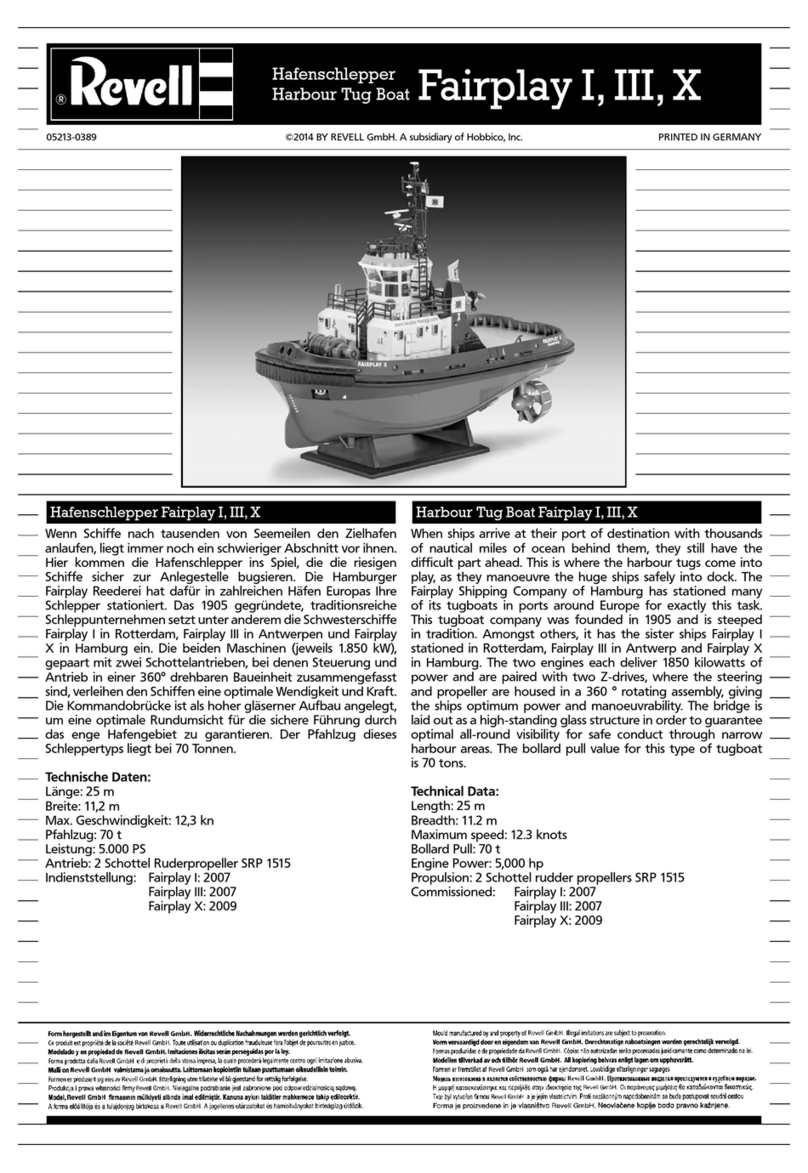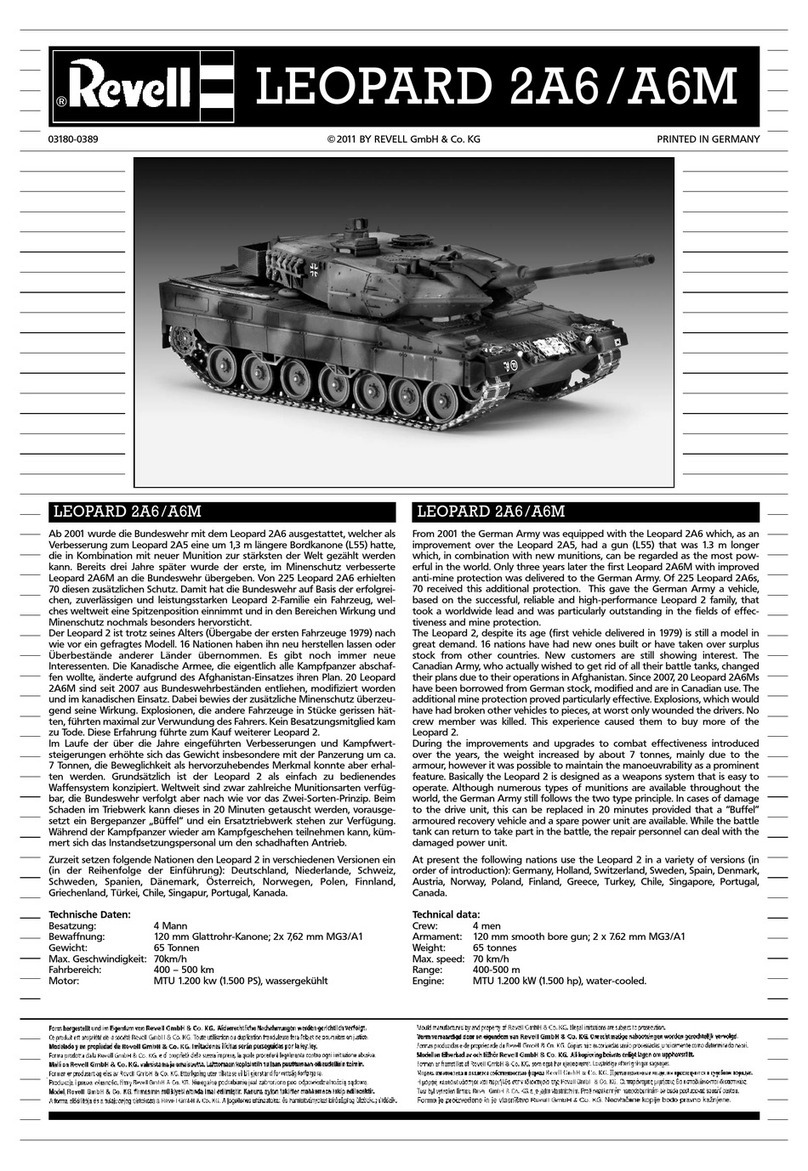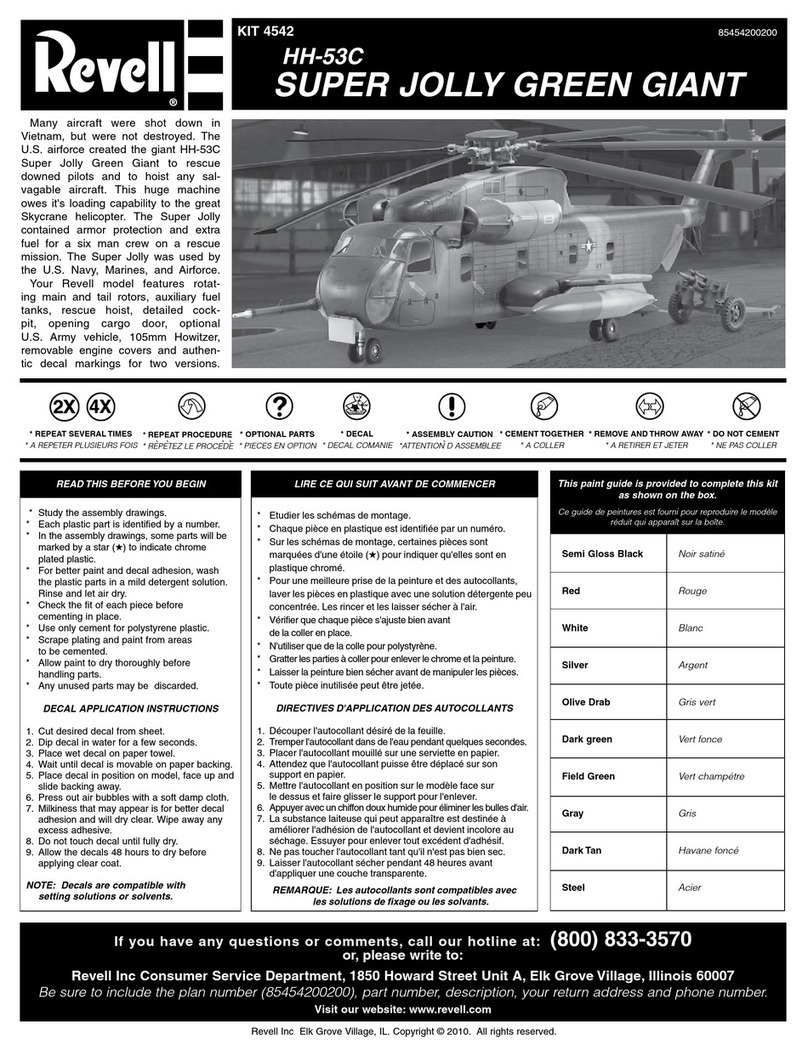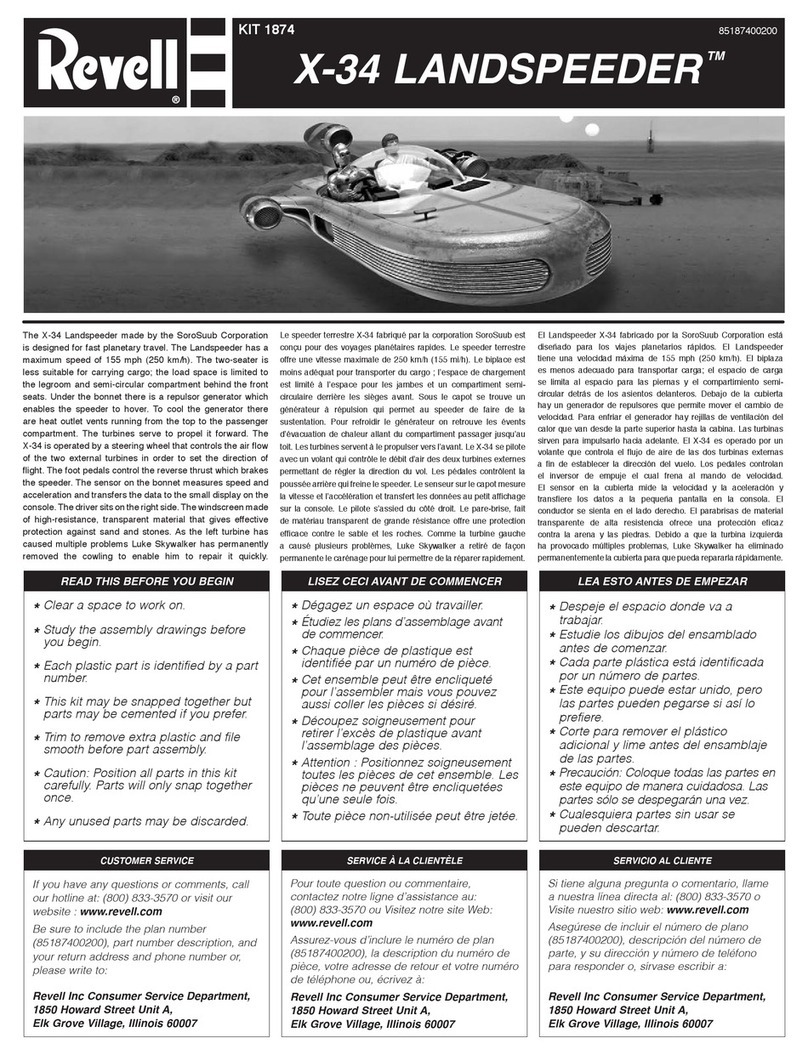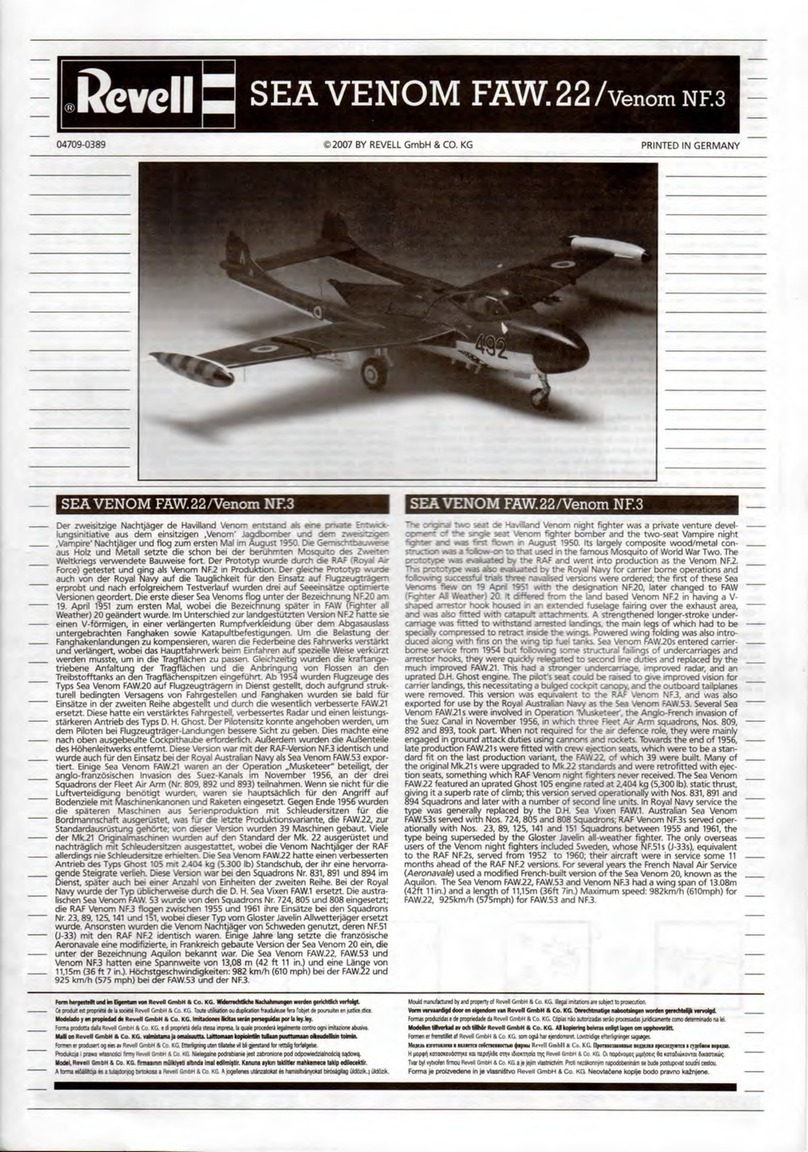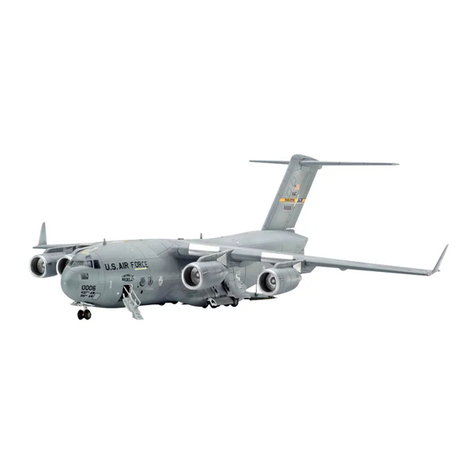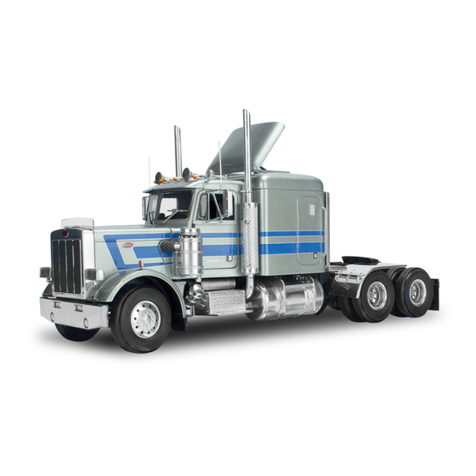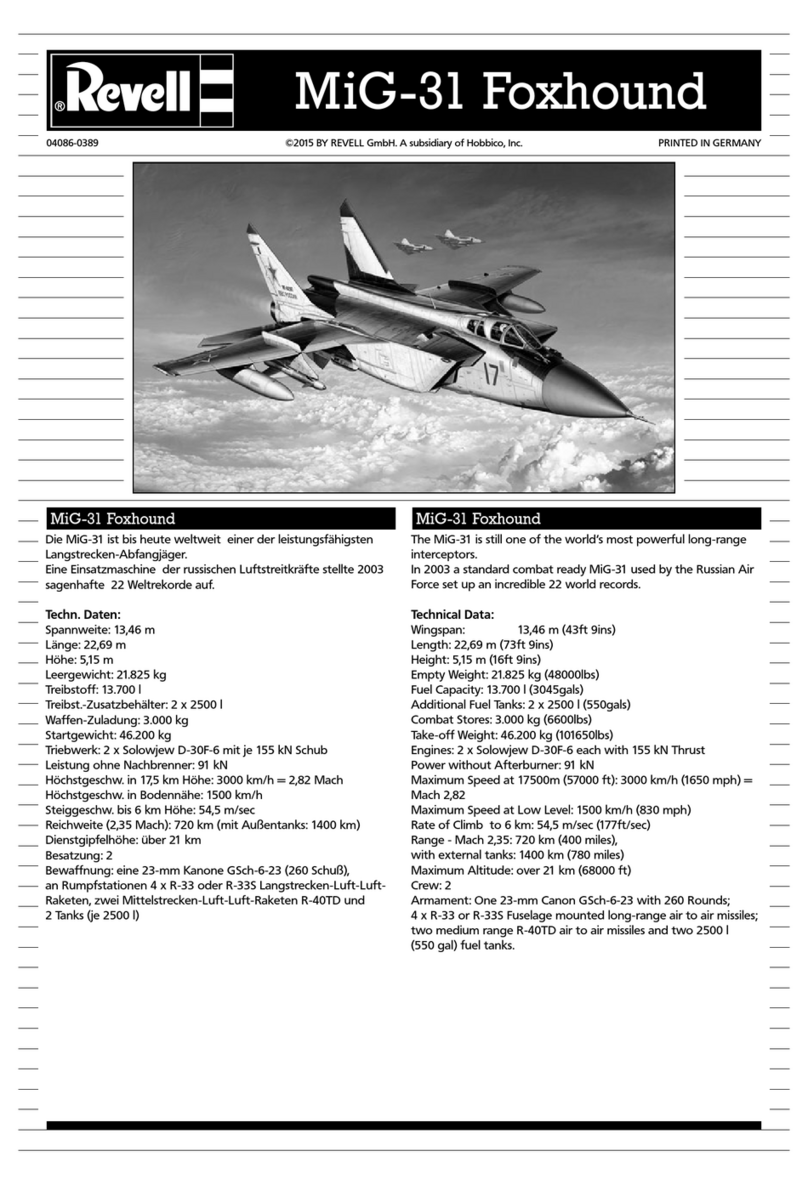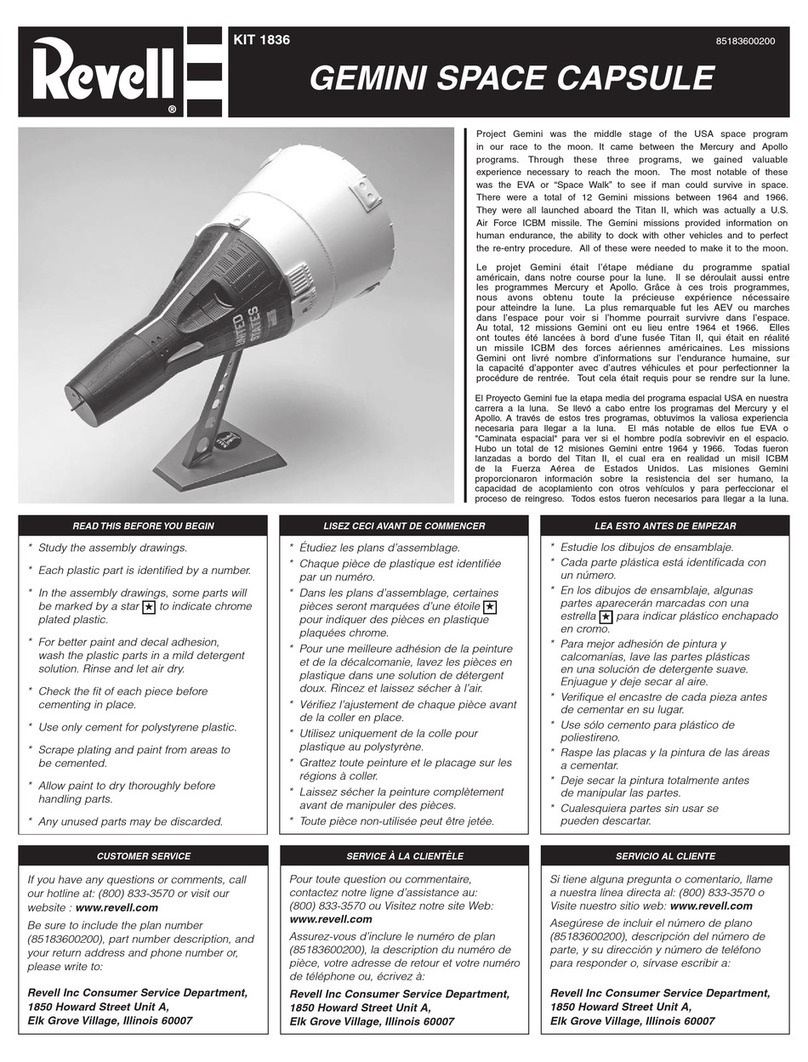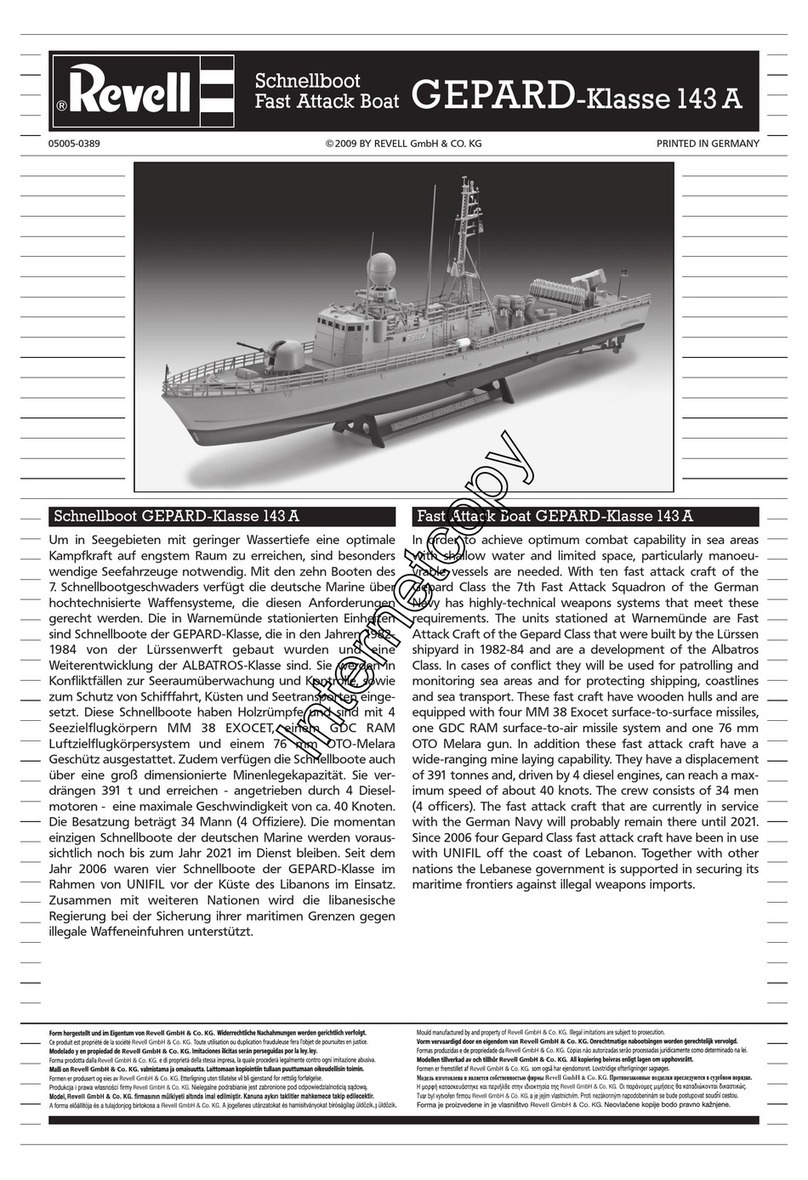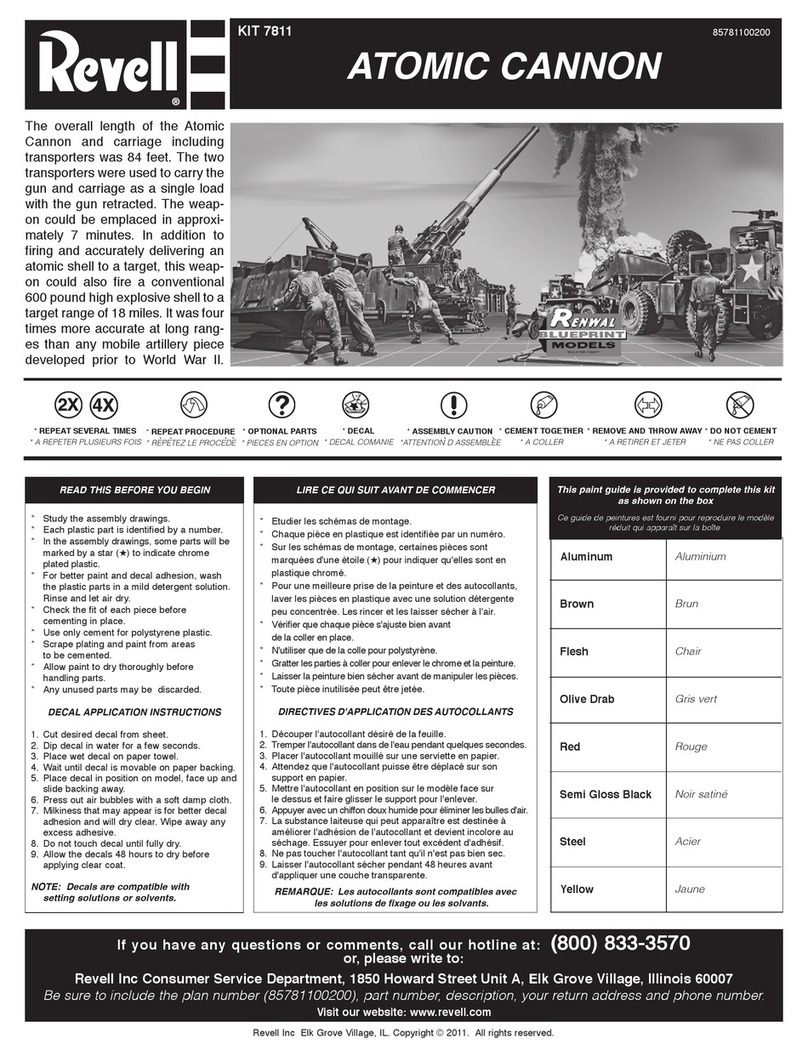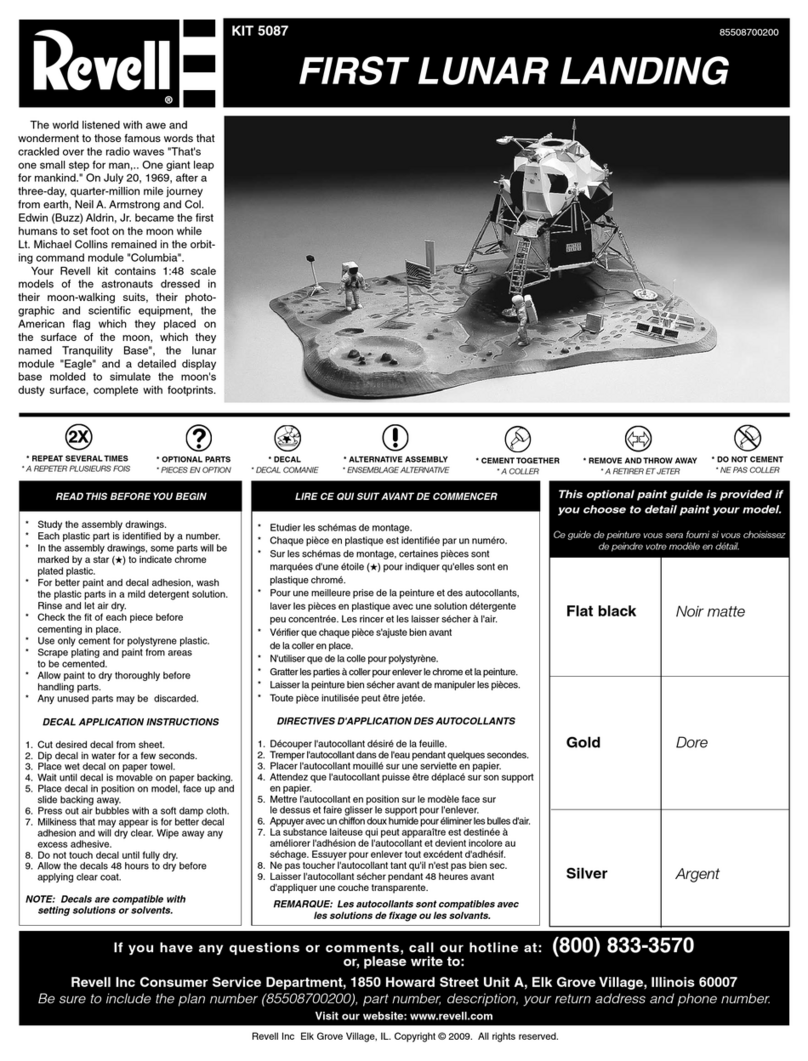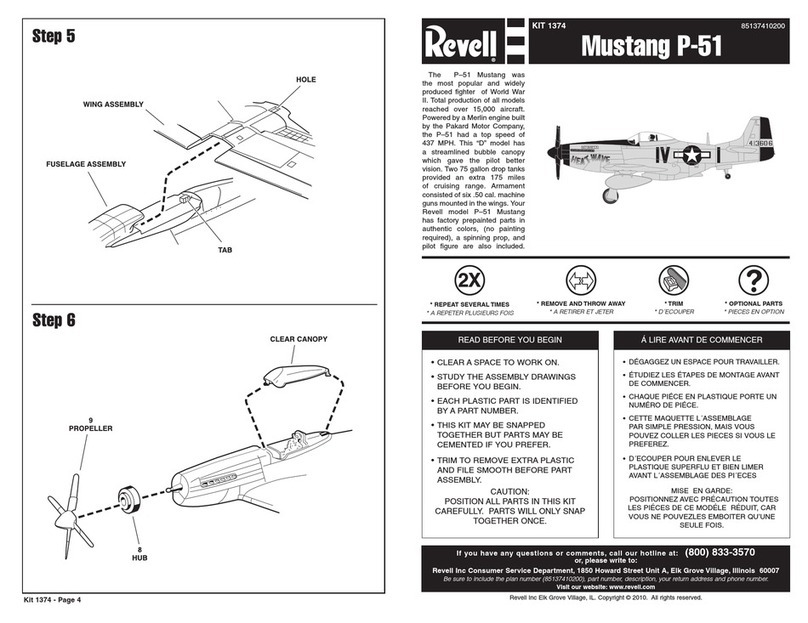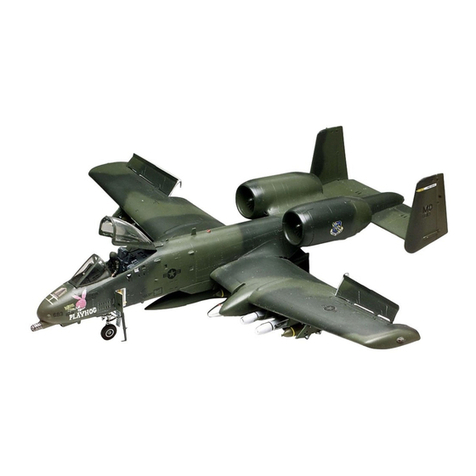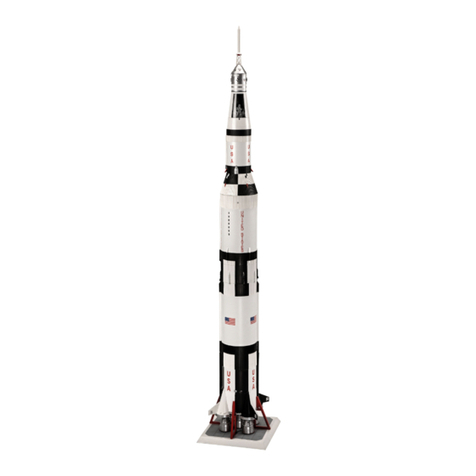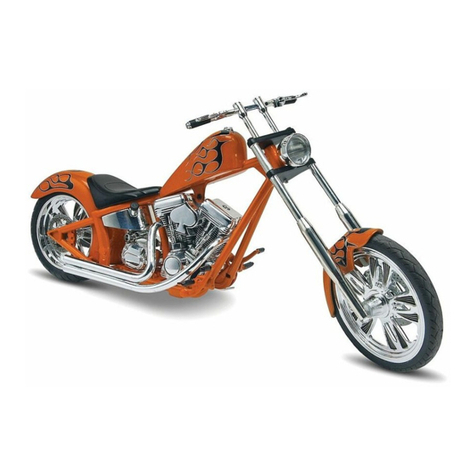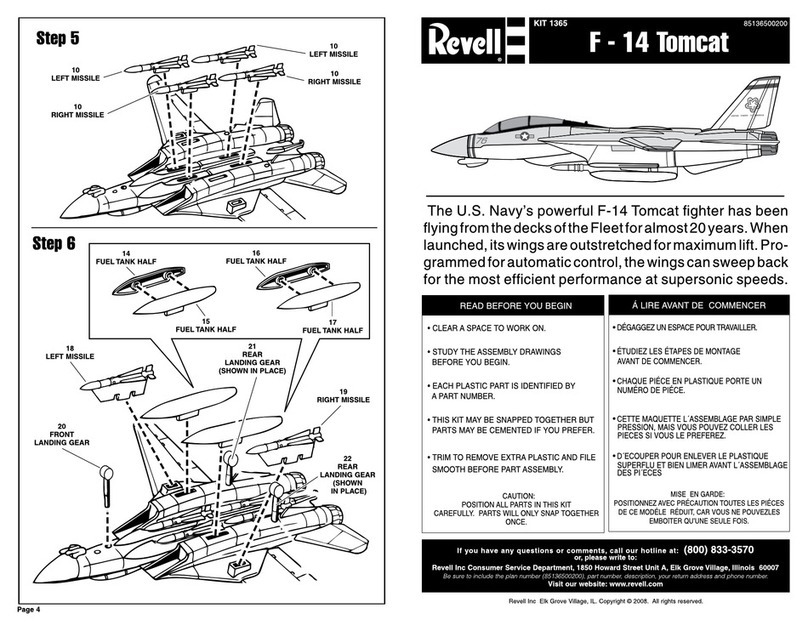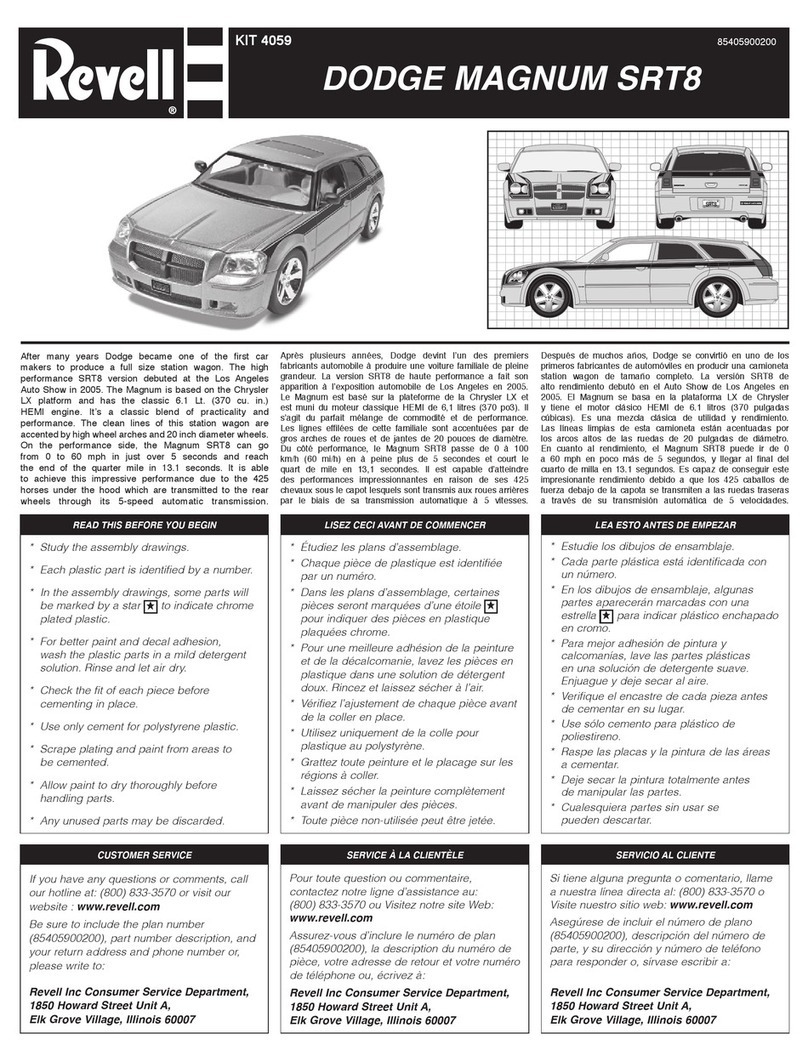16 17
• Power supply: ===
• Batteries: DC 9 V / 1 x 9 V
"6LR61" or "6F22"
(not included)
• Power supply:
110-240 V AC; 50-60 Hz
• Rated output: 6.4 V DC;
1200 mAh
Français
Consignes de sécurité :
• Cette notice d'utilisation doit
être lue dans son intégralité
et comprise avant toute mise
en service
• Veuillez conserver cette notice
d'utilisation et l'emballage qui
comportent des informations
importantes.
• L'utilisateur de ce modèle doit
se conformer aux consignes
d'utilisation figurant dans ce
mode d'emploi.
• Ce modèle convient aux
enfants de 8 ans et plus. Il
doit être utilisé sous la
surveillance des parents.
• Attention ! Ne convient pas
aux enfants de moins de 36
mois. Petites pièces. Risque
d‘étouffement !
• Ce modèle est conçu pour être
utilisé à l‘intérieur ou à l‘extérieur
par temps sec.
• Si vous souhaitez utiliser le
modèle à l'extérieur par temps
humide, veuillez absolument
res-pecter les consignes
suivantes : Les pièces électro-
niques de ce modèle sont
protégées contre la poussière
et les projections d’eau – mais
il convient cependant d'éviter
une immersion totale du
modèle ou une conduite
prolongée dans l'eau ! Après
utilisation, retirer la batterie du
modèle et laisser complètement
sécher tous les éléments ! Le
cas échéant, traiter les élé-
ments métalliques avec un
liquide hydrofuge (par ex.
WD40 ou autre) afin de
prévenir la corrosion. Protéger
la télécommande et le chargeur
de l'humidité !
• Maintenir les mains, le visage
et les vêtements amples
éloignés du modèle en marche.
• Éteindre la télécommande et
modèle lorsqu'ils ne sont pas
utilisés.
• Retirer les batteries de la
télécommande et du modèle
lorsqu'ils ne sont pas utilisés.
• Toujours garder les yeux fixés
sur modèle afin de ne pas en
perdre le contrôle. Le manque
d‘attention et la négligence
peuvent être la cause de
dommages importants.
• Ne pas actionner le modèle
à proximité de personnes,
d'animaux, de l'eau ou de
lignes élec-triques.
• Ce modèle ne doit pas être
utilisé par des personnes
ayant un handicap physique ou
mental. Si vous n'avez aucune
expérience avec les modèles
radiocommandés, nous vous
conseillons de faire appel à
une personne expérimentée
pour commencer.
• N'utilisez jamais le modèle si
vous avez pris des stupéfiants
ou bu de l'alcool.
• Ce modèle de doit pas être
utilisé sur les voies de circula-
tion automobile publiques !
• De manière générale, même
en cas de dysfonctionnements
et de pannes, il faut faire
attention à ce que la maquette
ne blesse personne.
• N'utiliser que des pièces de
rechange originales de Revell
Control pour les réparations
ou modifications du modèle.
Dans le cas contraire, le
modèle risquerait d'être abîmé
ou de présenter un danger.
• Afin de limiter les risques,
utilisez toujours le modèle
dans une position permettant
un évitement rapide le cas
échéant.
• Le modèle ne doit pas être
utilisé dans l‘eau salée.
• Renoncez à une utilisation en
hiver en plein air étant donné
que le sel d'épandage attaque
fortement votre modèle.
• Ne roulez pas sur les pelouses
ou prés avec le modèle. Les
morceaux de plantes peuvent
se prendre dans les pièces du
modèle et s'enrouler autour
des essieux, et surcharger
l'entraîne-ment de ce fait.
• Le modèle est équipé d'une
protection anti-surcharge qui
l'éteint en cas de surchauffe.
Dans ce cas, déconnectez le
modèle et la télécommande
et patientez jusqu'au refroidis-
sement suffisant du modèle ;
puis reconnectez la télécom-
mande et le modèle comme
décrit dans le mode d'emploi.
Évitez les alternances de
charge continuelles (par ex.
l'accélération maximale en
avant – l'accé-lération maximale
en arrière – l'accélération
maximale en avant etc.).
• Contrôlez l'assemblage correct
de votre modèle avant et après
chaque utilisation, en particu-
lier le logement correct des
bras de suspension (46602),
bielles de commande (46608)
et jambes de suspension
(46620), resserrez les vis
desserrées au besoin.
• Les bras de suspension
(46602), bielles de commande
(46608), jambes de suspension
(46620) et d'autres pièces de
l'essieu avant et arrière
peuvent se détacher sous
l'effet d'un choc – les contrôler
avant de continuer à utiliser le
modèle et les réenclipser ou
fixer si besoin est.
• Évitez de rouler continuelle-
ment à pleins gaz ou pleine
charge.
• Ne roulez pas sur les plages
de sable et d'autres sols ou
supports uniquement composés
de sable.
• Attention ! Ce modèle peut
atteindre des vitesses élevées
(de jusqu'à 25 km/h). Exercez-
vous d'abord sur une aire libre
d'au moins 3x5 mètres afin de
vous familiarisez avec le
modèle. N'ac-tionnez le levier
de commande qu'avec une
extrême précaution !
Consignes de sécurité pour la
télécommande :
• Pour la télécommande, nous
recommandons l’usage de
piles alcalines au manganèse.
Pour préserver l'environnement,
les piles non-rechargeables de
cette télécommande ou
d'autres appareils électriques
de la maison peuvent être
remplacées par des piles
rechargeables (batteries).
• Dès que la télécommande ne
fonctionne plus parfaitement,
les piles doivent être rempla-
cées par des piles neuves ou
rechargées.
• Les piles de la télécommande
sont vides et il convient de les
remplacer dès que la diode de
la télécommande clignote
lentement.
• La télécommande et le modèle
se déconnectent pour économiser
de l'énergie s'ils ne sont pas
utilisés pendant 10 minutes.
Consignes de sécurité
concernant les piles :
• Les piles rechargeables doivent
être retirées de la radiocom-
mande ou du modèle avant
leur chargement.
• Ne pas recharger les piles
jetables.
• Les piles rechargeables doivent
être rechargées en présence
d'un adulte.
• Ne pas mélanger des piles
de type différent ou des piles
neuves et des piles usagées.
• Seules les piles recommandées
ou de même type peuvent être
utilisées.
• Respecter la polarité indiquée
(+ et -) lors de l'insertion des
piles.
• Retirer les piles vides de la
télécommande ou du modèle.
• Ne pas court-circuiter les
bornes de raccordement.
• Retirer les piles de la télé-
commande si celle-ci n'est
pas utilisée pendant une période
prolongée.
• Retirer les piles de la radio-
commande et du modèle
si celles-ci ne sont pas utilisées
pendant une période prolongée.
• L'emploi de fonctions supplé-
mentaires réduit la durée de
fonctionnement.
• Lors de l'emploi du support
pour piles, le modèle réduit
automatiquement la vitesse
pour ne pas surcharger les
piles.
• Utilisez exclusivement des
accus de type AA NiMH à
partir de 2500 mAh ou l'accu
au lithium Revell Control
X-treme (#46705).
Consignes de sécurité pour
le chargeur :
• Ne pas recharger les piles
jetables.
• Ce chargeur ne doit pas être
utilisé par des personnes
(enfants y compris) souffrant
d‘un handicap physique ou
mental ou n‘ayant pas assez
de connaissances ou d‘expé-
rience en ce qui concerne
l‘utilisation de chargeurs, sauf
en cas de surveillance ou
après explication compétente
de la part d‘une personne
investie de l‘autorité parentale.
• Les enfants doivent être
surveillés - ce chargeur n‘est
pas un jouet !
• Le chargeur de la batterie Li
est conçu uniquement pour
le chargement de la batterie
du modèle. Son utilisation est
limitée au chargement de la
batterie du modèle, ne pas
l‘utiliser pour le chargement
d‘autres batteries.
• Contrôler régulièrement les
transformateurs, blocs
d'alimentation ou chargeurs
utilisés avec le modèle pour
s'assurer que les câbles,
connecteurs, boîtiers et autres
pièces ne présentent aucun
dommage. Réparer tout
dommage éventuel avant de
pouvoir utiliser les appareils à
nouveau.
• Veiller à la polarité correcte
du connecteur en raccordant
le chargeur à l'accu. Le
connecteur doit s'enfoncer
facilement dans la batterie
- NE PAS FORCER. Si le
connecteur n'est pas enfoncé
correctement dans la batterie,
cela pourrait endommager la
batterie et présenter un risque
de blessure.
Observer les consignes
de sécurité suivantes si
le modèle est équipé
d'une batterie au lithium
(24813, 24814, 24816,
24817) :
• Ne jamais jeter les batteries
au lithium dans le feu, ne
pas les conserver dans des
endroits chauds.
• Pour le chargement, utiliser
uniquement le chargeur fourni.
L'utilisation d'un autre chargeur
peut endommager durablement
la batterie ainsi que les compo-
sants qui la jouxtent et causer
des dommages corporels !
• Ne jamais utiliser de chargeur
pour batteries Ni-Cd / NiMH !
• Toujours effectuer le chargement
sur une surface non inflammable
et dans un environnement
sécurisé contre les incendies.
• Surveiller la batterie lors du
chargement.
• Ne jamais démonter ni
modifier les contacts de la
batterie. Ne pas endommager
ni percer les cellules de la
batterie. Il y a risque d‘explosion !
•La batterie Li doit être mainte-
nue hors de portée des enfants.
• Attention ! Avant le chargement
et après chaque utilisation, la
batterie et le moteur doivent
refroidir pendant au moins 20
minutes. Faute de quoi la
batterie t le moteur d'être
endommagés.
• Ne roulez jamais plus longt-
emps que 30 minutes même
avec une batterie performan-
te, puis patientez jusqu'au
refroidissement de la batterie
et du moteur imposé.
• Rechargez la batterie après
chaque utilisation en préventi-
on d'une décharge totale
nocive pour la batterie.
Rechargez la batterie tous les
3 mois, même si vous
n'utilisez pas le modèle.
Entretien et soin :
• Nettoyer le modèle avec un
chiffon propre et humide.
• Protéger le modèle et les piles
de tout ensoleillement direct
et/ou de toute source de
chaleur directe.
• Éviter tout contact de la
télécommande et du chargeur
avec l‘eau, car cela pourrait
endommager les composants
électroniques.
• Sous réserve de modifications
techniques et des couleurs !
• Nettoyez votre modèle après
chaque utilisation – il vous en
sera gré.
• Le recours à la garantie du
fabricant est exclu en cas
d'interventions sur le modèle.
Pour toute réparation et
commande de pièce détachées,
veuillez vous adresser à votre
revendeur spécialisé.
Caractéristiques techniques
Accu / batteries pour le modèle :
• Alimentation : ===
• Puissance nominale : 1 x DC
6,4 V / 650 mAh / 4,16 Wh
batterie rechargeable
LiFePo (incluse)
Alternative :
• Puissance nominale : DC 7,2
V / 6 x 1,2 V AA batterie
NiMH rechargeable (à partir
de 2500 mAh, non incluse)
• Puissance nominale : DC 9 V /
6 x 1,5 V AA LR6 (non incluses)
Remarque : renoncer à l'emploi
de batteries carbone et zinc
(Heavy Duty ou R6) !
Piles pour la télécommande :
• Alimentation : ===
• Piles : DC 9 V / 1 x 9 V 6LR61
ou 6F22 (non incluses)
Chargeur :
•Alimentation : 110-240 V AC ;
50-60 Hz ;• Puissance nominale :
6,4 V DC ; 1200 mAh
Nederlands
Veiligheidsaanwijzingen:
• Lees voor de eerste inbe-
drijfstelling de handleiding
helemaal door en zorg dat u
deze begrijpt.
• Bewaar de handleiding
en de verpakking a.u.b.,
deze bevatten belangrijke
aanwijzingen.
• Het model mag uitsluitend
volgens de aanwijzingen in
deze handleiding worden
gebruikt.
• Dit model is geschikt voor
volwassenen en jongeren
vanaf 8 jaar. Ouderlijk toezicht
is vereist wanneer jongeren
met het model rijden.
• Waarschuwing! Niet geschikt
voor kinderen jonger dan 36
maanden. Kleine onderdelen.
Verstikkingsgevaar!
• Dit model is geschikt voor
gebruik binnenshuis en bij
droog weer in de open lucht.
• Als u het voertuig buitenshuis
wilt gebruiken bij vochtig
weer, neem dan absoluut
de volgende aanwijzingen in
acht: De elektronische delen
van dit model zijn stof- en
spatwaterbestendig; voorkom
echter dat het model geheel
in water wordt ondergedom-
peld of langere tijd door
wa-ter rijdt. Verwijder de accu
na gebruik uit het model en
laat alles helemaal drogen!
Behandel metalen onderdelen
met een waterverdringer (bijv.
WD40 o.i.d.) om corrosie te
voorkomen. De zender en de
lader mogen niet nat worden!
• Houd de handen, het gezicht
en losse kleding uit de buurt
van het model wanneer
ermee wordt gereden.
from the remote control and
from the model.
• The connection terminals
may not be short-circuited.
• Please remove the batteries
from the remote control if it is
not to be used for an extended
period of time.
• Remove the batteries from
the remote control and model
if they are not to be used for
an extended period of time.
• The driving time is reduced
by the use of the additional
functions.
• When the battery case is used,
the model automatically
throttles back its speed in order
not to overload the batteries.
• Only use high-current NiMH AA
batteries with a capacity rating
of over 2500 mAh or the Revell
Control X-treme lithium battery
(#46705).
Charging unit safety
instructions:
• Non-rechargeable batteries
may not be charged.
• This charging unit is not
suitable for people (including
children) with physical or
mental limitations, or those
with insufficient knowledge
and experience of charging
units, unless under supervision
or following proper directions
from a parent or legal guardian.
• Children must be supervised –
the charging unit is not a toy!
• The charging unit for the Li
battery is specially designed
for the charging of the model
battery. The charging unit may
only be used to charge the
model battery, not other
batteries.
• Regularly check transformers,
mains adapters or chargers
that are used together with the
model for damage to cables,
plugs, housings and other parts
and repair any damage before
using the devices again.
• Pay attention to the correct
polarity of the plug when
connecting the charger to the
battery. Gently attach the plug
to the battery – DO NOT USE
FORCE. If the plug is not
correctly attached to the
battery, the battery can become
damaged and, under certain
circumstances, cause injury.
If the model is equipped
with a lithium battery
(24813, 24814, 24816,
24817), adhere to the
following safety information:
• Never throw lithium-ion
batteries into a fire or store
them in a hot location.
• Only use the charger supplied
to charge the battery. The use
of a different charger can result
in permanent damage to the
battery and adjacent parts,
and cause physical injury!
• Never use a charger for NiCd/
NiMH batteries!
• Always ensure that you charge
the battery on a fireproof
surface in a fire-resistant
environ-ment.
• Do not leave the battery
unsupervised during the
charging process.
• Never disassemble or alter
the battery contacts. Do not
damage or puncture the
battery cells. There is a risk
of explosion!
• The Li battery must be kept
out of reach of children.
• Attention! Allow the battery
and motor to cool down for 20
minutes before charging and
after each use. Otherwise, the
battery and motor can be
damaged.
• Never drive longer than 30
minutes with more high-perfor-
mance batteries and afterwards
let the battery and motor cool
down as described above.
• Recharge the battery after
every drive to avoid harmful
total discharge of the battery.
Charge the battery every 3
months even if the model is
not in use.
Maintenance and care:
• Please only use a clean, damp
cloth to wipe off the model.
• Protect the model and batter-
ies from direct sunlight and/
or direct heat.
• Never allow the remote
control and charging unit to
come into contact with water,
because the electronics will
be damaged as a result.
• Technical changes and differ-
ences in colour reserved!
• Clean your model after driving
– it will thank you.
• Interfering with the model
will invalidate the warranty.
Please contact your specialist
retailer for repairs and spare
parts orders.
Technical data
Rechargeable batteries/batteries
for the model:
• Power supply: ===
• Rated output: 1x DC 6.4 V /
650 mAh / 4.16 Wh
rechargeable LiFePo battery
(supplied)
Alternatively:
• Rated output: DC 7.2 V / 6x 1.2
V "AA" rechargeable NiMH
battery (over 2,500 mAh,
not included)
• Rated output: DC 9 V / 6 x 1.5
V "AA" LR6 (not included)
Note: never use zinc-carbon
batteries (heavy duty or R6)!
Batteries for the remote control:

